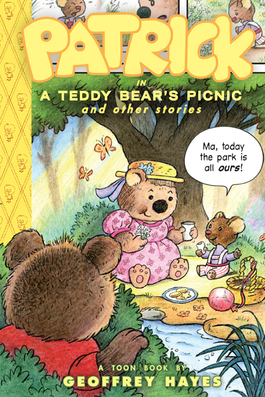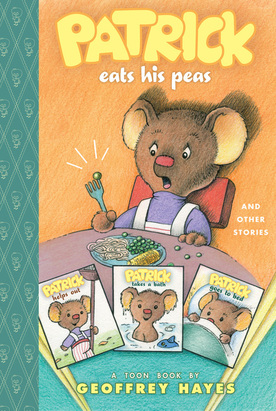Geoffrey Hayes has been making children's books since 1976, and has over forty titles to his credit. His first book, a picture book entitled Bear By Himself, introduced the appropriately-named character Bear, as he enjoyed a quiet day alone. When Bear appeared again two years later, it was in a book that was over one hundred pages and contained five stories, only now Bear had a name: Patrick. This sudden shift in format was one Patrick would undergo several times as Hayes moved the character from publisher to publisher over the years. Patrick sometimes appeared in a picture book, sometimes in a 8x8 book formatted for a spinner rack, other times as a board book, and most recently in comics. Through each of these incarnations, Hayes often reused stories that had appeared in earlier incarnations, sometimes redrawing the stories from scratch. (See the 1976 and the 1998 editions of Bear By Himself, and the 1989 book Patrick Eats His Dinner below.) With the success of his Benny and Penny comics for TOON Books, it was no surprise that Patrick again followed Hayes to a new publisher and a new format, in a mix of redrawn stories and new ones.

But before Patrick ventured into comics, Hayes garnered critical acclaim (including a Theodor Seuss Geisel Award) for his first foray into the form, his series for young readers Benny and Penny. The Benny and Penny books are masterpieces. Hayes's ability to capture the anxieties, the travails of socialization, and the tribulations of very young children is mind-blowing. Benny and Penny are brother and sister, and their stories take place for the most part in their backyard. They must negotiate playing with each other, meeting new neighbors, playing with friends they don't really like, and braving the dark, all of which they do without adult supervision. Mom is always nearby, and sometimes calls to them from off panel, but really Benny and Penny need to figure things out for themselves. By creating an adult-free world, Hayes allows for his characters and his readers to engage with these social anxieties at an emotional level, the way a child would, and so Benny and Penny and the reader must work through the problem, and find a moral solution. There's none of the heavy-handed guiding message that underpins so many children's picture books. Instead, we get children and situations that ring so true that both children and adults can identify with Benny and Penny, find comfort in recognizing their own insecurities, and learn the lesson by experience rather than by being taught.
The Patrick TOON books have the same verisimilitude as the Benny and Penny books, but for Patrick, his parents are an ever-present source of security. As a result, Patrick reads as a younger character (even though he gets sent to the store by himself in one of the stories), and his relationship with his parents--his mother in particular--is in some ways the main topic of the books. Yes, Patrick must contend with the childhood annoyances of taking a nap, taking a bath, eating his peas, and many other typical, "Aw, ma, do I have to..." scenarios, but with the exception of a bullying story in Patrick in A Teddy Bear's Picnic, the books are about the interactions between parent and child. The trick then becomes the balance between Patrick's perspective and his parents' perspective.
 In Patrick in the Teddy Bear's Picnic, Hayes manages to tip the balance in Patrick's favor. Mom is there, and a parent reader can recognize her amusement and annoyance at some of Patrick's foibles, but Patrick's experience is the one that both the adult and child reader identifies with. This is in part because Patrick is alone in more of the book than he is in Patrick Eats His Peas. He retrieves a balloon at the park, endures nap time, and takes the aforementioned trip to the store. But it is mainly because Mom's actions are the way in which a child would experience them. She is on the sidelines, almost always placid, happy, and comforting, except for rare, and brief, bursts of annoyance. The focus is on what Patrick is feeling, and Mom, as far as he sees it, is just there as a source of support.
In Patrick in the Teddy Bear's Picnic, Hayes manages to tip the balance in Patrick's favor. Mom is there, and a parent reader can recognize her amusement and annoyance at some of Patrick's foibles, but Patrick's experience is the one that both the adult and child reader identifies with. This is in part because Patrick is alone in more of the book than he is in Patrick Eats His Peas. He retrieves a balloon at the park, endures nap time, and takes the aforementioned trip to the store. But it is mainly because Mom's actions are the way in which a child would experience them. She is on the sidelines, almost always placid, happy, and comforting, except for rare, and brief, bursts of annoyance. The focus is on what Patrick is feeling, and Mom, as far as he sees it, is just there as a source of support. In Patrick Eats His Peas, however, the balance tips in the parents' favor, and the book is less satisfying. Here Patrick makes a mess of the leaves his father has just raked, offers similar "help" to his mother in the kitchen, trashes the bathroom during his bath, and insists on making fudge at bedtime. At each of these points, Mom and Dad's expression is highlighted, usually given a full panel to the parent alone, and often in classic cartoon style, with shock lines radiating from her head. This makes the moments feel more like parental observations, than children's conflict. The point seems to be, "Isn't it frustrating (or amusing) when your kid does this?" instead of tackling what Patrick is feeling. In the case of Patrick offering help in the yard and in the kitchen, for example, we don't get the loneliness and boredom of an only child whose parents are both busy. We get the parents' frustration at having their tasks hampered by Patrick's "help." In the end, it makes Patrick Eats His Peas a disappointment. Instead of the insightful parsing of the conflicts of childhood that Hayes is so good at, we get something closer to anecdotes. Is it a bad book? No. It's still Hayes, and therefore better than most children's books. It's just not in the same league as his other TOON books.
In Patrick Eats His Peas, however, the balance tips in the parents' favor, and the book is less satisfying. Here Patrick makes a mess of the leaves his father has just raked, offers similar "help" to his mother in the kitchen, trashes the bathroom during his bath, and insists on making fudge at bedtime. At each of these points, Mom and Dad's expression is highlighted, usually given a full panel to the parent alone, and often in classic cartoon style, with shock lines radiating from her head. This makes the moments feel more like parental observations, than children's conflict. The point seems to be, "Isn't it frustrating (or amusing) when your kid does this?" instead of tackling what Patrick is feeling. In the case of Patrick offering help in the yard and in the kitchen, for example, we don't get the loneliness and boredom of an only child whose parents are both busy. We get the parents' frustration at having their tasks hampered by Patrick's "help." In the end, it makes Patrick Eats His Peas a disappointment. Instead of the insightful parsing of the conflicts of childhood that Hayes is so good at, we get something closer to anecdotes. Is it a bad book? No. It's still Hayes, and therefore better than most children's books. It's just not in the same league as his other TOON books.All images are copyrighted © and owned by their respective holders


+-+001.jpg)












